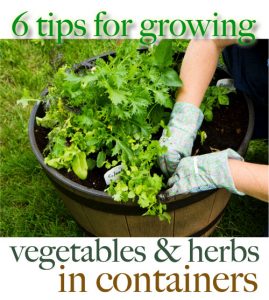Growing fresh vegetables and herbs is a great way to save money and control what pesticides go into your body. If you don’t have the space to grow your own garden, don’t worry — you can grow your own vegetables and herbs in containers on your desk, patio or balcony.
What vegetables and herbs can you grow in containers?
- All herbs
- All greens: collards, lettuce, mustard, swiss chard
- Egg plant and peppers of all types
- Tomato varieties: husky cherry red, patio, bush early girl, bush goliath, better bush
- Squash and zucchini
- Cucumbers, beans, beets
- Carrots, onions, potatoes, radishes
Here are six simple steps to get your container garden started:
- Transplant instead of seeds. Instead of planting seeds, pick up transplants at the garden center. Transplants are seedlings that have already begun to grow. Not only does this save you a considerable amount of time, but you’re vegetables will begin to harvest much sooner.
- Don’t skimp on the potting mix. Look for a premium quality potting mix that holds moisture but also drains well. This will help give your plant roots the balance of air, moisture and stability to grow. Check the bag labels and look for ingredients such as: aged (composted) bark, perlite, lime or dolomite and sometimes moisture-holding crystals. Quality potting mix stays fluffy all season long; it does not contain actual dirt that would compact with frequent watering.
- Choose the correct pot. Make sure you choose a large enough pot to accommodate your plants as they mature. Also look for a drainage hole in the bottom. Color matters too: dark colored containers absorb heat that could potentially damage your plant’s roots.
- Plants like to eat too. If your potting mix came with fertilizer already mixed in, you may need to still feed your plants. Fertilizer mixes designed to feed for several months run out sooner in hot weather with frequent watering.
- Provide plenty of sunshine. The sun drives energy for production and for making sugars, acids and other compounds responsible for flavor. Make sure pots on a deck or porch get enough sunlight. Without sun, the fruits will not ripen and the plants will be stressed.
- Water on a regular basis. To produce well vegetables, water plants at the soil level after the sun goes down.
Thanks to our friends at Family Corner for the inspiration.
Need more? Check out our Garden Pinterest Board.
Tags: family fun, Home, Housing Market, living in milwaukee, Milwaukee, milwaukee lifestyle, shorewest, Shorewest Realtors, things to do, tips and advice, Wisconsin
Categories: DIY


Leave a Reply